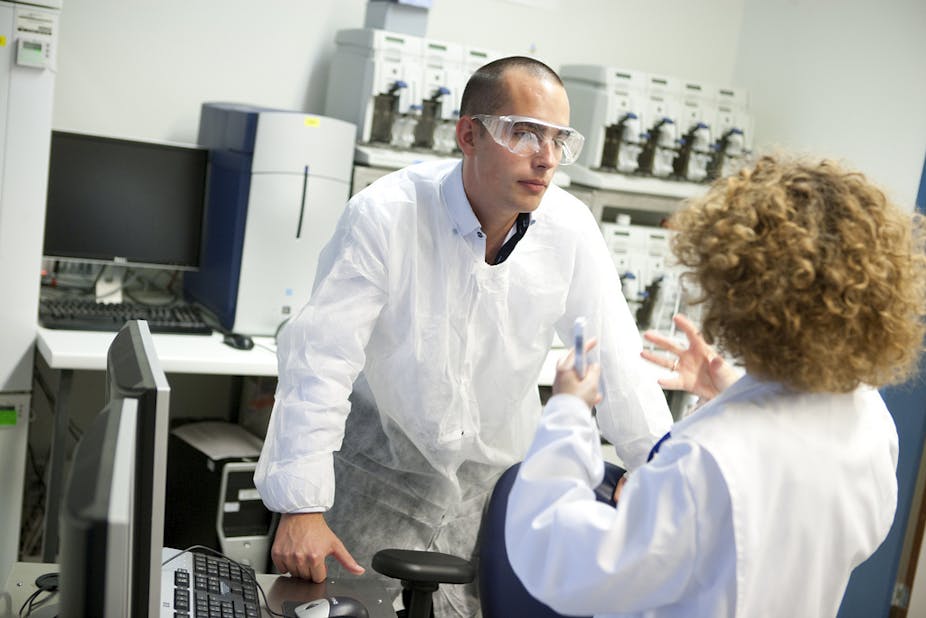At a time when unprecedented levels of investment are being made in university infrastructure in nations such as China and India, it is worth reflecting on how Australia has built its notable areas of research strength. Going back to the creation of the Australian National University in 1946, we have periodically focused our attention and resources on research institutions of global significance.
The health sciences cluster in Melbourne and the Smart State Institutes in Brisbane can be included in this list. In a recent paper with Jonathan Staggs in the Cambridge Journal of Economics, I explore the formation of the Smart State Institutes, which have raised over $1 billion in investment and employ 1300 people, and the factors that led to their creation. We argue that better understanding of the conditions and processes that led to their formation can improve future policies for building internationally competitive research infrastructure.
The Institute of Molecular Bioscience, Australian Institute for Bioengineering and Nanotechnology, Queensland Brain Institute and Diamantina Institute have different histories, ambitions and funding models, but they are collectively known as the Smart State Institutes. Based at the University of Queensland, they emerged as a result of a combination of influential government policies at federal and state levels, strategic decision making by the university, the efforts of highly entrepreneurial academics, and crucially, substantial investment from a generous philanthropist.
Initiatives of this scale require many essential ingredients. At the time of the formation of the Institutes in the late 1990s and early 2000s, the federal government’s policies, such as Backing Australia’s Ability, increased investment and encouraged focus in research. There was a move from block funding to competitive grants, and national research priorities were established.
Queensland’s Smart State policy, which grew up alongside the Institutes, clearly identified the objective of investing in science to diversify the economy away from its reliance on rocks and crops. Remarkably for a state politician - and to his eternal credit - Premier Peter Beattie channelled significant funds into initiatives that would not produce returns until long after he had retired.
The University of Queensland embarked on a strategy of being selective in its research funding, especially favouring large, inter-disciplinary research centres. University leaders, such as former Vice-Chancellors John Hay and Paul Greenfield, enthusiastically championed the creation of the Institutes, and leading academics, such as John Mattick, took on the entrepreneurial role of marshalling resources towards emerging new opportunities.
Luck and fortunate timing played their role. As one person interviewed put it: “a large number of planets needed to be aligned”. Politics and contested objectives needed to be worked through nationally, locally and within university structures. Despite these continuing and occasionally fractious negotiations, lessons emerged about clarity and stability in policy and strategy from the creation of these Institutes. Federal and state policy directions were clearly identified. University leadership was strategic in focus and strong in application. Academic entrepreneurs had ambitious scientific agendas and the skills to articulate their vision and cumulatively build their resources.
Yet despite all these elements being in place, it took the philanthropy of Irish-American Chuck Feeney to act as animateur, catalysing their coordination. His Atlantic Philanthropies invested over $100 million in the Institutes, and he actively and successfully lobbied politicians in Canberra and Brisbane.
Atlantic Philanthropies used its resources to target scientific areas of concern and cleverly leverage government investments. Its model of providing external legitimacy to new initiatives and capacity to pull diverse communities of interest together is surely replicable on a smaller scale.
Our paper researches the creation of the Institutes, not their subsequent performance. As we argue, this will take many more years, if not a further decade, to ascertain. What is clear, however, is that their formation required the concatenation of a wide range of factors, the realignment of which is extremely unusual in Australia. As many of our national competitors recognise, such research infrastructure is a crucial component of modern economies and, despite the uncertainties surrounding their eventual contributions, their consistent investments do not leave such things to chance.
Given the multiplicity of factors behind their formation, capitalising on the establishment of these Institutes is not a short-term option. Such strategic investments require patience and continuing support beyond state and Commonwealth electoral cycles.
The creation of the Institutes required foresight and fortune, but they also depend on statesmanship and bipartisanship for their true long-term benefits to be realised. Research institutes of this nature are highly complex organisms and, like limbs, they cannot grow back once they have been cut off.
Universities are central actors in the knowledge economy. Understanding the conditions in which they best perform this role and contribute to the industries of tomorrow is a critical input to future policy-making. In Australia, it may help make our investments in globally important research infrastructure less episodic and more strategic.

